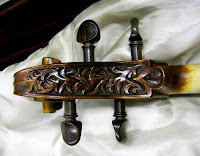time to finish an old old project...
i've wanted to make a flute headjoint since i was a kid. a number of years ago, i bought a few broken flutes off eBay and took them apart quite brutally to learn how they were made. i din't know a thing about solder at that time, so i burnt the plating off the poor instruments to take them apart. it was hell when the pads caught fire... so please don't try this at home. anyway, i've decided to make at least a headjoint, if not an entire flute one of these days.
π is my friend
to make a flute headjoint, i first measure and cut a sheet of brass to length. dimensions are easy, we know the flute is 19mm in diameter and the headjoint tapers to 17mm at the cork assembly. using the formula Circumference = π × diameter , i can work out how wide the sheet metal needs to be at both ends. the brass i'm using here is 0.016" sheet brass available at most hobby stores.
the tools we need are in the pictures. the specialty roller and mandrel can be found
here . the site is not very user friendly/searchable, those of us who carried their book catalogs around in our college days (and who didn't... : ) should have no problems. if not, be patient and look through their Pdf catalogs and find the flute body mandrel and small roller meant for brass instrument repairs and such. i'll need also, soft (plumbing use) and hard (jewelery making use) solder. the different fluxes and my favorite hot little baby, the propane torch.
the most important rule i try to observe when using a torch is: don't be an idiot. i'm not going to show pictures of me soldering because my hands were very busy when the torch was going. i get very nervous using the darn thing. also, this idiot does not want to lead other idiots toward burning down their own kitchens or garages or "shop".
the sheet brass is beaten with the rubber tipped mallet on the mandrel to form a tube. when i get close, i switch to the roller to get more bend and curve out of it. as it gets harder, i soft solder a tab of brass to one end, this helps to hold the thing in place while i work on the shaping the tube. it's easier said than done, i actually spent about an hour trying to make the ends line up and meet to form a tube.
the small tab is removed and the tube is held in place with broken rings bent from thick steel wire. the ends of the sheet brass is hard soldered together and thus form a seam. hard soldering is pretty nerve wrecking because the brass is thin and it has to be red hot, but heat it too long the thin metal collapses. don't heat it enough the solder goes no where, all in all not a pleasant experience at all. a fan blows at my face constantly so that i may breathe. in my mind, all kinds disastrous accidents are happening...
after hard soldering, the tube looks like a mess. it needs to be cleaned up. the seam is filed clean and the whole sucker is buffed until shinny. the inside is sanded flat too with emery cloth on a large drum stick.
the lip plate is formed from thicker brass. i don't have a die, so it is beaten into shape on the round end of the flute body mandrel.it's hard to explain how i did it. i just whacked it with the mallet, that's all.the underside becomes a mess and is sanded clean with a wire brush wheel on a Dremel and some emery cloth.
the riser is made from stock brass rod and somehow fitted to the curve of the lip plate... i'm not sure how i did it actually, it just happened... so here's where i am currently:
to be continued...













































